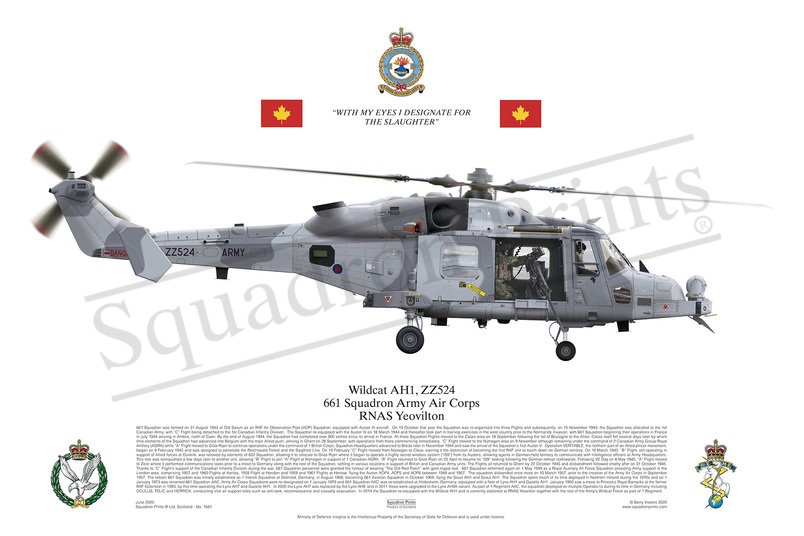#1581 Wildcat AH1 ZZ524

Description
Squadron Prints Lithograph No. 1581 - ZZ524, Wildcat AH1, 661 Squadron Army Air Corps, RNAS Yeovilton.
661 Squadron was formed on 31 August 1943 at Old Sarum as an RAF Air Observation Post (AOP) Squadron, equipped with Auster III aircraft. On 19 October that year the Squadron was re-organised into three Flights and subsequently, on 15 November 1943, the Squadron was allocated to the 1st Canadian Army, with “C” Flight being detached to the 1st Canadian Infantry Division. The Squadron re-equipped with the Auster IV on 18 March 1944 and thereafter took part in training exercises in the west country prior to the Normandy Invasion, with 661 Squadron beginning their operations in France in July 1944 arriving in Amblie, north of Caen. By the end of August 1944, the Squadron had completed over 900 sorties since its arrival in France. All three Squadron Flights moved to the Calais area on 18 September following the fall of Boulogne to the Allies. Calais itself fell several days later by which time elements of the Squadron had advanced into Belgium with the main Allied push, arriving in Ghent on 28 September, with operations from there commencing immediately. “C” Flight moved to the Nijmegen area on 9 November although remaining under the command of 2 Canadian Army Group Royal Artillery (AGRA) while “A” Flight moved to Gilze Rijen to continue operations under the command of 1 British Corps. Squadron Headquarters advanced to Breda later in November 1944 and saw the arrival of the Squadron’s first Auster V. Operation VERITABLE, the northern part of an Allied pincer movement, began on 8 February 1945 and was designed to penetrate the Reichswald Forest and the Siegfried Line. On 19 February “C” Flight moved from Nijmegen to Cleve, earning it the distinction of becoming the first RAF unit to touch down on German territory. On 18 March 1945, “B” Flight, still operating in support of Allied forces at Dunkirk, was relieved by elements of 652 Squadron, allowing it to relocate to Gilze Rijen where it began to operate a highly secret wireless system (“IS9”) from its Austers, allowing agents in German-held territory to communicate with Intelligence officers at Army Headquarters. This role was relinquished a few days later to another unit, allowing “B” Flight to join “A” Flight at Nijmegen in support of 1 Canadian AGRA. “B” Flight returned to Gilze Rijen on 22 April to resume its “IS9” tasking following the German retreat northwards. Following VE Day on 8 May 1945, “A” Flight moved to Zeist where it performed communications tasks prior to a move to Germany along with the rest of the Squadron, settling in various locations in support of British and Canadian Army units. The Flights all returned to Ghent by 22 October 1945 and disbandment followed shortly after on 31 October 1945. Thanks to “C” Flight’s support of the Canadian Infantry Division during the war, 661 Squadron personnel were granted the honour of wearing “The Old Red Patch” with gold maple leaf. 661 Squadron reformed again on 1 May 1949 as a Royal Auxiliary Air Force Squadron providing Army support in the London area, comprising 1957 and 1960 Flights at Kenley, 1958 Flight at Hendon and 1959 and 1961 Flights at Henlow, flying the Auster AOP4, AOP5 and AOP6 between 1949 and 1957. The squadron disbanded once more on 10 March 1957, prior to the creation of the Army Air Corps in September 1957. The reborn 661 Squadron was initially established as 1 Interim Squadron at Detmold, Germany, in August 1968, becoming 661 Aviation Squadron in October 1969, flying the Sioux AH1 and Scout AH1. The Squadron spent much of its time deployed in Northern Ireland during the 1970s and on 1 January 1973 was renamed 661 Squadron AAC. Army Air Corps Squadrons were re-designated on 1 January 1978 and 661 Squadron AAC was re-established at Hildesheim, Germany, equipped with a fleet of Lynx AH1 and Gazelle AH1. January 1993 saw a move to Princess Royal Barracks at the former RAF Gütersloh in 1993, by this time operating the Lynx AH7 and Gazelle AH1. In 2005 the Lynx AH7 was replaced by the Lynx AH9 and in 2011 these were upgraded to the Lynx AH9A variant. As part of 1 Regiment AAC, the squadron deployed on multiple Operations during its time in Germany including OCULUS, TELIC and HERRICK, conducting vital air support roles such as anti-tank, reconnaissance and casualty evacuation. In 2014 the Squadron re-equipped with the Wildcat AH1 and is currently stationed at RNAS Yeovilton together with the rest of the Army’s Wildcat Force as part of 1 Regiment.
You may also like
-
SIGNED King's Birthday Flypast 2024, Memorial Formation
ZJ913; ZK374; ZK38129 Sqn; BBMFRAF Coningsby
